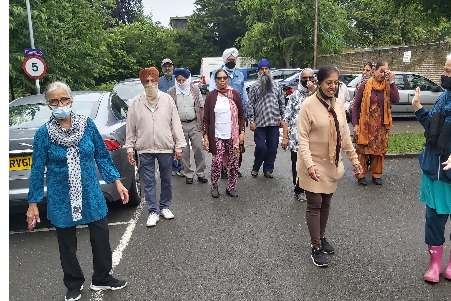
This project delivers weekly health walks at local venues to reduce loneliness and improve mental wellbeing.
This scheme creates opportunities for social interaction and can be targeted at any demographic groups who are socially isolated. The guided walks provided are often particularly valuable to older people, helping to re-build their confidence and giving the skills needed to exercise outdoors.
Activities for the project may include:
- 4-5 weekly ‘Walk and Talk’ sessions, each 60 minutes long, led by a trained health walks leader
- Two health walk training sessions to train 10+ walk leaders annually
- 15 x virtual walk sessions for elderly and infirm residents who are housebound. This includes advice about strength and balance exercises to help with falls prevention
- ‘The Big One’ – a walk-through of different wards/local areas, involving groups of residents of all ages and backgrounds
The project’s sustainability can be increased by training the volunteers to independently plan and deliver walks in the future. This approach will create a network of walkers who can confidently welcome new participants by the end of the project.
If targeting participants from a diverse ethnic background, staff and volunteers should be used who can speak participants’ appropriate languages. The project idea can then demonstrate that residents from different faiths and ethnic backgrounds can integrate and exercise together. English speaking practice could also be built into the walks or rest breaks.
Target audience and engagement
- The key target audience for this project are people who are socially isolated. It is more likely to be made up of older people, however it is open to any age group
- Promote your project by hosting or attending events and using publicity materials, such as leaflets or posters
- Use existing community group networks, or seek out specialist and charity organisations who work with your target group, to raise awareness of your activities
- Engagement can also be through social media, with specific targeting to potential user groups
Reach
- Large (70 – 100 participants)
- Geographically - anywhere there are green, open spaces, or other spaces. Example spaces include, but are not limited to, parks and woodlands, estates and managed gardens, canal and river footpaths
Equipment needed
- Walk resources, including maps, work sheets and activity packs to prompt discussion (if needed)
- Hi-Vis vests
- Walking shoes/jackets (if required)
Resources needed
- Project Leader:
- Oversee the project, ensure the participants feel safe and are enjoy their experience
- Track equipment and ensure it is returned and cleaned if necessary
- Ensure all funding criteria and documentation is met (if required)
- Run risk assessment for safeguarding, injuries and to identify any other concerns which may affect project delivery
- Gather feedback from participants to feed into future sessions or projects
- The project lead should have the requisite level of DBS, understand health and safety needs and preferably be first aid trained - Volunteers/Project Officers:
- Help answer queries
- Contribute to overseeing activity and potentially resolve any equipment issues
- Run the scheduled walks
- Prompt conversations - Trained walk leader for running the walks
- Storage Space:
- You will need somewhere to store equipment. This could be at a community centre, in an existing office, or perhaps another local business that has a storage facility - Publicity:
- Flyers and posters for publicity of the sessions - Refreshments:
- Tea, coffee and snacks at every session, this will lighten the mood and offers an incentive for people to come. This may include stopping off for refreshments at a café along the walking route, or bringing your own as part of a picnic event built into the walk plan
Estimated project costs
- Project publicity £150
- Weekly walks management/walk leader cost £3,250
- DBS checks £200
- Volunteer expenses £300
- PPE equipment (Hi-Vis vests etc.) £300
- Final event costs (if part of project) £500
- Public liability insurance (if needed) £170
Top tips/key learnings
- Ensure that you have committed and enthusiastic volunteers, this will really help to make the project a success and engage participants
- Be prepared for the unexpected and be willing to be flexible in the delivery of your programme - this may include having a plan to cut walks short if they are taking longer than anticipated due to participants’ abilities
- Work towards training participants to become walk leaders themselves to encourage participant retention and sustainability
- A key challenge of this project can be to build participant’s confidence to get out and have those conversations that will improve their mental outlook. As the project goes on listen to and engage with your participants to see what works and what they like, and adjust your approach accordingly
- Take advantage of the training programme that is offered by Walking and Cycling Grants London
Maximising local contacts
- Contact charities and organisations that specialise in your chosen target audience. Strong working relationships with these groups will encourage participant referrals from their network and will improve information sharing
- Engage with your local council - they may be able to lend you equipment, help market the project, help secure a local space for meetings, or provide advice/learning
This project idea was provided by Southall Community Alliance
If you decide to run your own version of this project in your community, please email us at wcgl@groundwork.org.uk. We love to hear that we are inspiring people to walk and cycle.